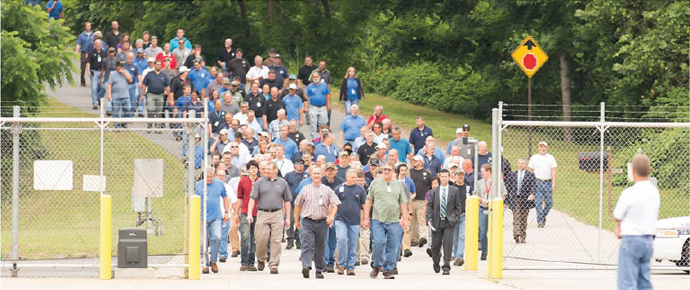Talk about a vote of confidence. GE Aviation is investing nearly $200 million in four North Carolina sites primarily because of the state’s work force.
One of the locations – Asheville – will be home to a new, $125-million plant for producing Ceramic Matrix Composite (CMC) components for the next-gen LEAP commercial aircraft engines being developed by CFM, a joint venture of GE Aviation and French aerospace concern Snecma. Composites are used routinely in aircraft manufacturing, but CMC is the first composite being used in the hot section, or core, of the engine. GE will produce a stationary component called a turbine shroud initially. Less air is required to cool the part, so more air is applied to propulsion, making the engine more efficient. More CMC components will follow.

Employees at the GE Aviation facility in Asheville arrive for the announcement that GE Aviation will bring additional jobs and investment to the area.
Meanwhile, GE Aviation is also investing in its facilities in Durham, where the engines are assembled, and in West Jefferson and Wilmington, where components are manufactured. The company has invested in building up its supply of skilled workers in the state and is no hurry to lose them.
“Every state will tell you they have the best work force,” says Kelly Walsh, a GE Aviation spokeswoman familiar with the CMC facility site search, which involved locations in 12 states. “They all come to the table with that. North Carolina’s proven record was really the tipping point. We have a hard time finding the skilled labor we need to fill jobs. So when we have a track record of success like we have had in North Carolina, we will do everything we can to stay there.”
The new Asheville facility is being built on a former Old Dominion Trucking site adjacent to GE Aviation’s existing plant, which will be re-purposed over time for additional CMC work. Employees at that plant were thrilled to learn their jobs were secure and that their new workspace would be at virtually the same location they were already in.
‘Pivotal’ Supply Chain State
Logistics is a close second to labor in GE’s North Carolina play, says Walsh.
“North Carolina is a big deal to our supply chain, and we wanted to be able to really gear up for executing on a record order backlog across all four of those sites,” she says. Orders already are on the books for more than 4,500 LEAP engines from airlines around the world awaiting delivery of next-generation Boeing 737 MAX, Airbus A320neo and COMAC C919 aircraft. “We definitely look to North Carolina as a very pivotal part of our supply chain. Outside of headquarters in Ohio, it’s probably one of the most important states to us.”
Walsh says GE Aviation will break ground on 125,000-sq.-ft. (11,600-sq.-m.) facility in Asheville later this year and will be shipping certified parts from there in 2014. “I think we are ahead of the curve in the industry in doing this,” she notes. “The other North Carolina sites will keep doing what they do, but every facility has to prepare for this new LEAP engine. The CMC work is unique to Asheville, but the upgrades at West Jefferson, Wilmington and Durham are so we can increase our capacity for LEAP.”

Asheville
Asheville was the best candidate for the new CMC plant of the four North Carolina options, says Walsh. “We had a vision for each site. We are constantly evaluating workload throughout all 80 of our sites in the supply chain on quality and cost,” she relates. “Our supply chain leader always has said the North Carolina shops are some of the best. They are focused, they have an entrepreneurial spirit, and the work force is great, on time and on cost. So we had a vision for all four of them that included growth. Asheville was a key site to repurpose, because the existing work being done there wasn’t the highest value work. But we worked across the sites in North Carolina, and the localities really made this happen.” Asheville and Buncombe County are clearly among those.
“There was a lot of competition surrounding this particular location for the CMC work that will be done here,” says Ben Teague, senior vice president of the Asheville-Buncombe County Economic Development Coalition. “We think it will unlock hundreds of millions of dollars of further development opportunities.”
Teague says his team knew in mid-2012 that a significant project was getting organized, and by December, discussions were under way. “We knew there was significant competition from what we knew to be Georgia, Mississippi, Alabama, Ohio, Delaware and several other states. It became known as Project CMC, because that’s what we were told would be produced.”
Against the Odds
GE Aviation’s internal methodology for scoring potential investment locations had Asheville in the least desirable position, with its saving grace being its work force, says Teague. “They told us this investment would put us in the best possible position for future investment,” he notes, “that not only would our work force continue to work, but their grandkids would be working on this technology. It would have a multigenerational effect on the community.
“We knew they meant business. We knew we were in trouble. And we knew we had to do something to win,” says Teague. “We also knew they wanted to stay at a location where they already were and that they wanted to expand.” The Asheville site would make that very difficult. Negotiations with the owner of the existing facility fell through, and other options in the area were not practical.
Old Dominion agreed to sell its site next to GE Aviation and be relocated as long as its operations were uninterrupted. “Before we could even start construction on the GE Aviation site, we had to build Old Dominion’s entire building and move them to their new location.” And GE wasn’t going to budge on when it wanted its new CMC plant operational. (The deal with Old Dominion was essentially a swap. The county would buy a new site and build the company a building, and Old Dominion gave the county its former site.) One more hurdle: “In North Carolina, counties do not have a design-build process, but we got legislation passed to allow us to do a design-build for the county. Kudos to our local delegation in the state legislature for helping to make that happen.”
Had Old Dominion not agreed to the deal, GE Aviation’s CMC production would be taking shape in another city, if not state. “North Carolina would have lost,” says Teague. “This technology being here in Asheville is the crux of the state expansion.
“GE views us as a partner,” he adds. “They will tell you that the work force that is on site now at GE is very innovative and very productive relative to other plants, and that helps make them profitable. That’s part of what kept them looking at Asheville.”
Project X?
Teague says the approval process for a $2.7-million incentives package and a $15-million building purchase was tricky inasmuch as the company had to remain anonymous, which irked some in the community – it was known as “Project X.” But the incentives hearings were public.
It was all worth the effort, says Teague, who was present at the Paris Air Show when GE Aviation President and CEO David Joyce announced the investment, referring to the company’s “partnership with Asheville” and the industry-changing technology that would be built here.
“We had an announcement here locally, too,” says Teague. “To see the hundreds of workers at the GE plant here walk down the hill to where their new plant would be – this parade of people – was amazing and emotional. These were the people and families we had worked so hard for. So many people in the community had worked so hard in different ways to make this possible.”
The real story, says Teague is the ground-breaking technology that GE Aviation will produce in the Great Smoky Mountains. “But when you go through that public process, it shifts peoples’ perception to the incentives, and we had to work hard to keep the message on point and address concerns that nearly $18 million was a lot of money to be making available to the mysterious Project X. But at the end of the day, it was understood to be a great technology play, and people understood why it had to be that way for a time.”
A very significant technology play, GE Aviation’s Walsh reiterates. “This is the very first mass production facility for CMCs in jet propulsion. And it’s in North Carolina, so needless to say we’re putting our money on Asheville and trust the work force to execute on this.”
If the workers’ enthusiastic march to see the new plant site is any indication, it will in spades.
